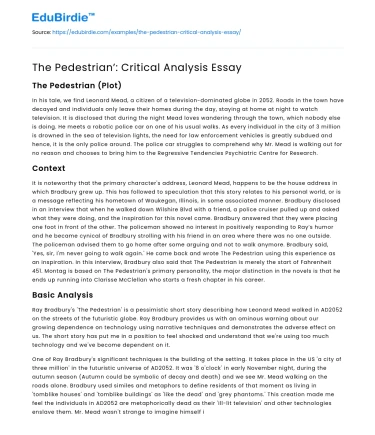The Pedestrian (Plot)
In his tale, we find Leonard Mead, a citizen of a television-dominated globe in 2052. Roads in the town have decayed and individuals only leave their homes during the day, staying at home at night to watch television. It is disclosed that during the night Mead loves wandering through the town, which nobody else is doing. He meets a robotic police car on one of his usual walks. As every individual in the city of 3 million is drowned in the sea of television lights, the need for law enforcement vehicles is greatly subdued and hence, it is the only police around. The police car struggles to comprehend why Mr. Mead is walking out for no reason and chooses to bring him to the Regressive Tendencies Psychiatric Centre for Research.
Context
It is noteworthy that the primary character's address, Leonard Mead, happens to be the house address in which Bradbury grew up. This has followed to speculation that this story relates to his personal world, or is a message reflecting his hometown of Waukegan, Illinois, in some associated manner. Bradbury disclosed in an interview that when he walked down Wilshire Blvd with a friend, a police cruiser pulled up and asked what they were doing, and the inspiration for this novel came. Bradbury answered that they were placing one foot in front of the other. The policeman showed no interest in positively responding to Ray’s humor and he became cynical of Bradbury strolling with his friend in an area where there was no one outside. The policeman advised them to go home after some arguing and not to walk anymore. Bradbury said, 'Yes, sir, I'm never going to walk again.' He came back and wrote The Pedestrian using this experience as an inspiration. In this interview, Bradbury also said that The Pedestrian is merely the start of Fahrenheit 451. Montag is based on The Pedestrian's primary personality, the major distinction in the novels is that he ends up running into Clarisse McClellan who starts a fresh chapter in his career.
Save your time!
We can take care of your essay
- Proper editing and formatting
- Free revision, title page, and bibliography
- Flexible prices and money-back guarantee
Basic Analysis
Ray Bradbury's 'The Pedestrian' is a pessimistic short story describing how Leonard Mead walked in AD2052 on the streets of the futuristic globe. Ray Bradbury provides us with an ominous warning about our growing dependence on technology using narrative techniques and demonstrates the adverse effect on us. The short story has put me in a position to feel shocked and understand that we're using too much technology and we've become dependent on it.
One of Ray Bradbury's significant techniques is the building of the setting. It takes place in the US 'a city of three million' in the futuristic universe of AD2052. It was '8 o'clock' in early November night, during the autumn season (Autumn could be symbolic of decay and death) and we see Mr. Mead walking on the roads alone. Bradbury used similes and metaphors to define residents of that moment as living in 'tomblike houses' and 'tomblike buildings' as 'like the dead' and 'grey phantoms.' This creation made me feel the individuals in AD2052 are metaphorically dead as their 'ill-lit television' and other technologies enslave them. Mr. Mead wasn't strange to imagine himself in 'the central plain of a windless desert in Arizona.' Bradbury demonstrates to us that the town has become barren and lifeless, not too unlike our own towns and our technological reliance.
The town becomes alive in the morning and full of the 'thunderous surge of cars and gas stations open'. 'Gas stations open' relates to our growing dependence on fossil fuels, which has an enormous effect on the resources of the world. Due to our reliance on cars, factories, and so on, these resources are depleting to supply our growing need for energy. People are called 'scarab beetles' in the text. Bradbury describes 'the great insect rustling and ceaseless jockeying for positions'. The onomatopoeia increases commotion and noise, contrasting efficiently with the night's silence and loneliness. The roads become 'like the dry season, all stone and bed and moon radiance'. Bradbury demonstrates to us the natural world as well as the man-made world, leaving us to create the connections. He means that our use of technology has an effect not only on the manner we live our life but also on the natural world.






 Stuck on your essay?
Stuck on your essay?

